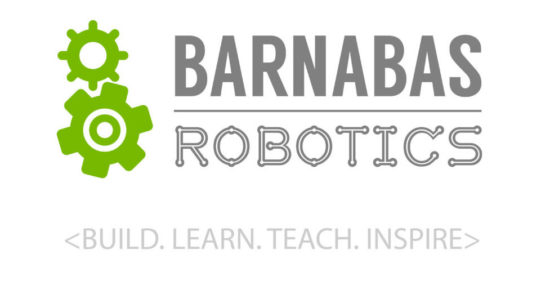- PAGE SETTINGSClick on the gear to simplify view
- Settings

Lesson Overview
Disciplinary Core Ideas
- PS3.B: Conservation of Energy and Energy Transfer: Energy can also be transferred from place to place by electric currents, which can then be used locally to produce motion, sound, heat, or light. The currents may have been produced to begin with by transforming the energy of motion into electrical energy. (4-PS3-2),(4-PS3-4)
- Planning and Carrying Out Investigations: Make observations to produce data to serve as the basis for evidence for an explanation of a phenomenon or test a design solution. (4-PS3-2)
- Constructing Explanations and Designing Solutions: Apply scientific ideas to solve design problems. (4-PS3-4)
- Energy and Matter: Energy can be transferred in various ways and between objects. (4-PS3-1),(4-PS3-2),(4-PS3-3),(4-PS3-4)
Learning Target(s)
Technical Skills
- Understanding of basic electronics concepts including open-circuits, closed-circuits, short-circuits, voltage and current
- Ability to create a simple circuit with an LED using AA batteries.
- Ability to extrapolate necessary voltage for two LED circuits and beyond.
Life Skills
- Teamwork
- Freedom to fail
Essential Question(s)
- What is a circuit?
- What is the difference between open and closed circuits?
- What is current?
- How does voltage effect a circuit?
Key Vocabulary
- Circuit
- Open-Circuit
- Closed-Circuit
- Current
- Voltage
- Short-Circuit
Depth of Knowledge Levels Addressed
- Level 1: Recall and Reproduction
- Level 2: Skills and Concepts
- Level 3: Strategic Thinking and Reasoning
- Level 4: Extended Thinking
Barriers to Learning
- Minimal experience with household electronics.
- No working knowledge of electricity.
Anticipatory Set
- Learn basic electrical engineering concepts and use them to create a simple LED circuit
Independent Practice
- Assembly of LED circuit with a partner. Time permitting, the assembly of a two LED circuit with three partners.
Final Assessment, project or product
- Drawing the two LED circuit schematic.
Lesson Materials

Lesson Plan
Review
- What are the four main parts of a robot?
- Which kind of engineer works on each part of the robot?
Step 1: Electronic Basics (20 minutes)
Draw a robot. I like to draw Eve from Wall-E. Eve’s battery is analogous to a human heart. Draw a heart on your robot. We cannot live without our hearts pumping blood to the rest of our bodies, and robots cannot turn on without a battery. Human hearts pump blood, similar to how robots batteries supply electrical power.
Eve’s wires are analogous to a human’s arteries, veins, and capillaries. Draw a full circulatory system on your robot. We cannot be healthy if our arteries are blocked or veins are weak and cannot supply appropriate blood flow to our body. Similarly, issues with wiring can seriously affect the robot even if the battery is fully charged.
Eve’s current flow is analogous to human circulation. Just as blood flows in one direction in our bodies: from our heart out to arteries into capillaries in our bodies where oxygen is used to veins that carry the blood back to our heart where the oxygen can be replaced (actually the blood also flows separately to the lungs to be reoxygenated, it is written here thusly for simplicity), electricity flows through a circuit in a particular direction so that the robot works best. Just as the circulatory system makes a loop, a circuit makes a loop too.
Vocabulary
- Closed-circuit: A closed-circuit is when there is a complete loop in your electrical system. In this case electricity can flow.
- Open-circuit: An open-circuit is when the loop is broken. In this case electricity cannot flow. The robot cannot live if we have an open circuit, much like how we cannot live if blood is not circulating through our bodies.
- Short-circuit: A short circuit is when you have a loop, but electricity is flowing too fast. Just like blood being pumped through our bodies too quickly, too much electricity flowing through a circuit can harm the robot.

Step 2: Building Our First LED Circuit (1.5V) (10 minutes)
Draw the LED circuit schematic shown below. Encourage the students to determine the voltage of the circuit by examining their parts. HINT: it is written on the battery.
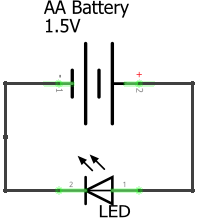
Explain that the voltage determines how fast electricity flows through our circuit. The higher the voltage, the faster electricity moves. Explain that electricity flowing through a circuit is called ‘current,’ and that there are positive and negative sides on both the battery as well as the LED. They need to line up the positives and negatives for the circuit to work.
The schematic is the plan for our circuit. You can compare it to the blueprint of a building. At this point, distribute the robotics kits to your students. Have them take out:
- AA Battery
- AA Battery holder
- LED
Have the students build the circuit with the components they just took out. Let them figure out how to correctly put the battery into the battery holder, as well as which side is positive(red) and which is negative(black). The positive end of the LED has a longer wire.
…IT DOESN’T WORK!
Your students will notice that the LED does not light up. Ask them why (HINT: the 3V LED needs at least 3 volts to turn on). At this point, use the metaphor of a waterfall to describe voltage. Explain that the taller a waterfall is, the more power you will get out of it. It is the same with voltage. More voltage, more power. Ask the students how we can get the necessary 3V to light up the LED (DO NOT use the 9V battery. Instead, combine two AA batteries!).
Vocabulary
- Current: Current is simply the flow of electricity.
- Voltage: Voltage is what creates current, or the flow of electricity through a circuit. A larger voltage will cause a faster flow of electricity through a circuit.


Step 3: Building The 3 Volt Circuit (15 minutes)
Start by drawing the 3V LED schematic.
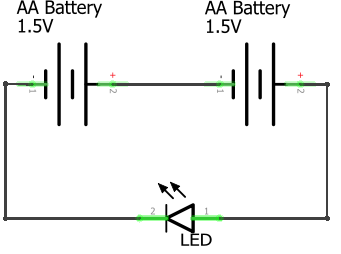
Ask the students to identify the difference between this schematic and our previous one (there are two batteries). How many total volts is the LED getting now.
Have the students work together to build the circuit. Everyone will need to find a partner to have enough batteries for the circuit. If you have an odd number of students, you as the instructor can fill in as a partner for one of your students.After giving the students an opportunity to build the circuit themselves, bring the class together and walk through building the circuit one step at a time.

A “parallel” circuit puts them next to each other so that the voltage stays the same, but there is more current available (like putting two same height waterfalls next to each other).
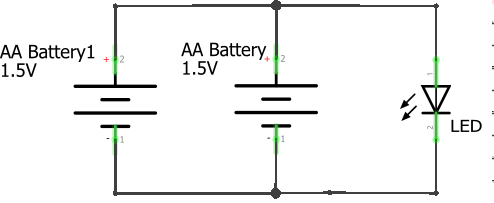
Another error is for students to attempt to use more than two batteries to light a single LED. While this will likely give a blighter glow to the LED it is likely to damage it as well. Another common error is to connect the batteries incorrectly. Remember that The red wire of one battery must be connected to the black wire of the other battery. In a circuit where the two red wires are connected or the two black wires are connected electricity will not flow. Going back to the waterfall analogy, we can increase the height of our waterfall by connecting batteries together from negative to positive. We are taking additional steps in the same direction, up. However connecting two like ends, whether negative or positive, has the opposite effect. One battery is attempting to increase the height of the waterfall while the other is decreasing it.
Step 4: The Two LED Circuit (15 minutes or as time permits)
Now that the students have successfully made the 3V LED circuit it’s time to give them a bigger challenge. Instead of pairs, have the student’s get into groups of four. Between the four of them they should have enough batteries to light two LEDs. Give them the opportunity to attempt a two LED circuit on their own. Unlike the one LED circuit, this two LED circuit has multiple working schematics. See below.
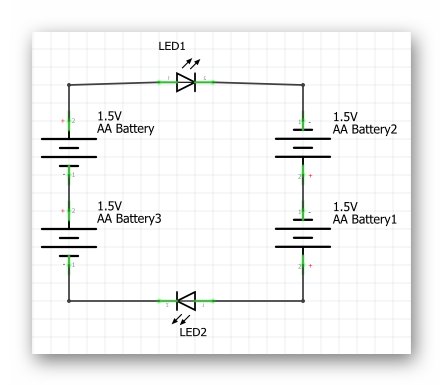
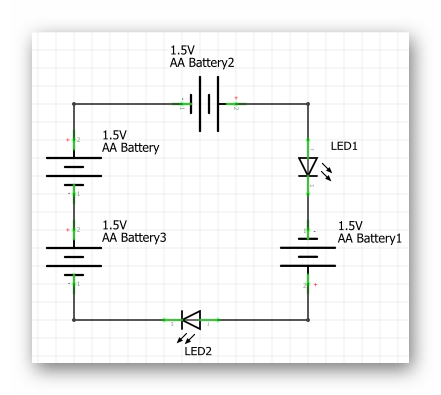
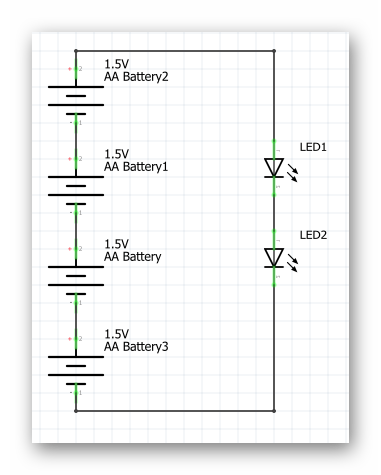
You should challenge your students to build the circuit without showing them the schematics above. These are more for the benefit of the teacher, so you may be more equipped to help your students with troubleshooting issues.


REFLECTION
- What is a circuit? What is the difference between an open-circuit and a closed-circuit.
- Why did our initial circuit (one AA battery) not light the LED?
- If I wanted to light 5 LEDs, how many AA batteries would I need?
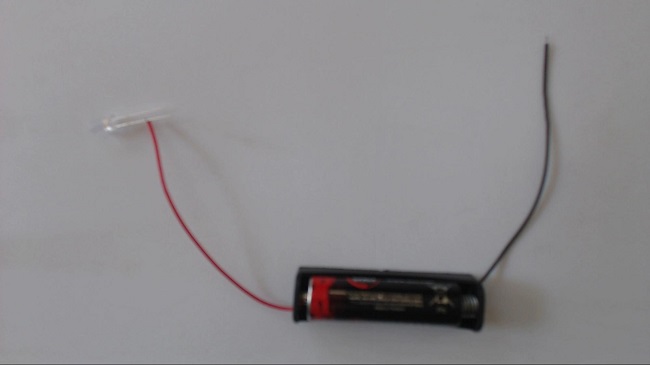 Connect the + wire(red) of the first battery to the + leg(the longer leg) of the LED.
Connect the + wire(red) of the first battery to the + leg(the longer leg) of the LED.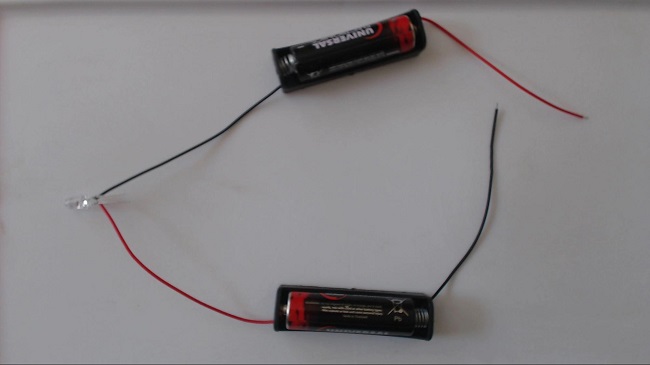 Connect the - leg(the shorter leg) of the LED to the - wire(black) of the second battery.
Connect the - leg(the shorter leg) of the LED to the - wire(black) of the second battery.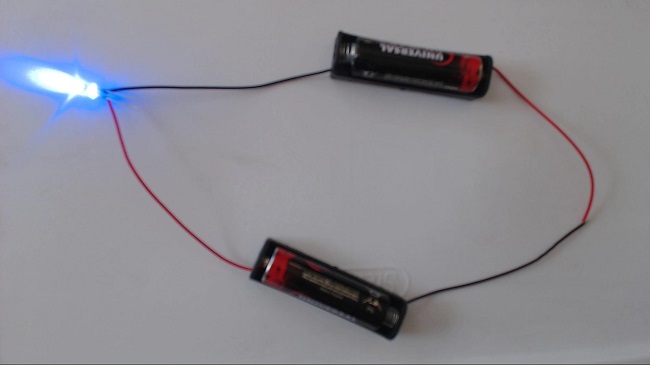 Connect the + wire(red) of the second battery to the - wire(black) of the first battery.
Connect the + wire(red) of the second battery to the - wire(black) of the first battery.